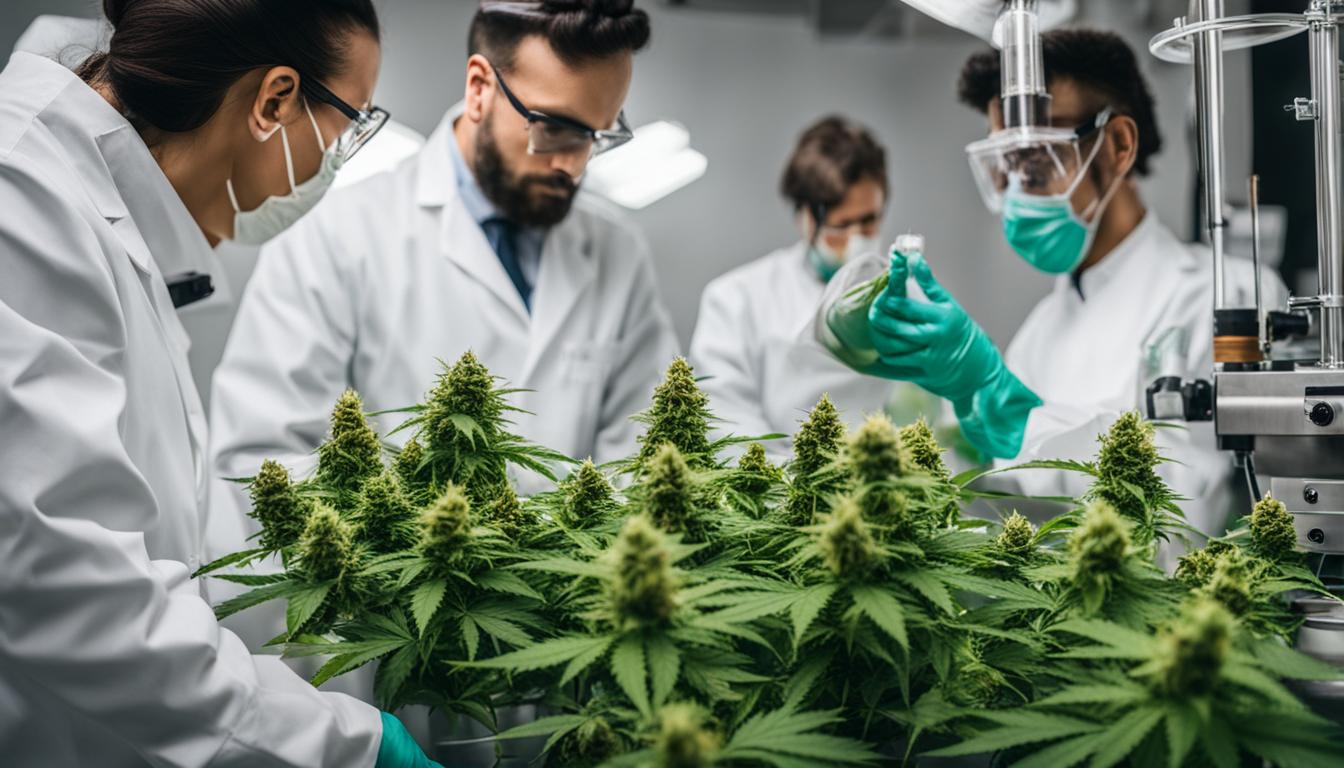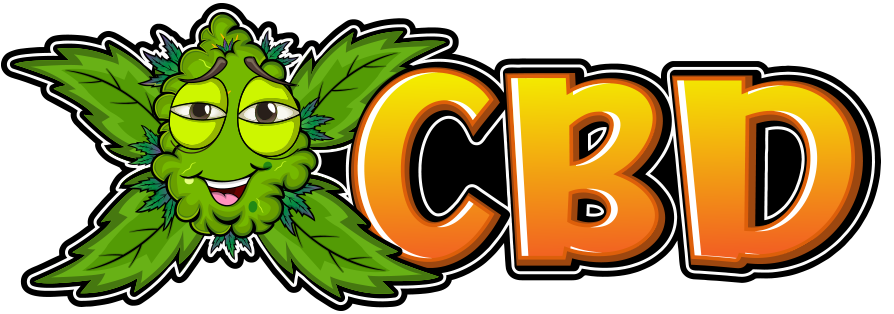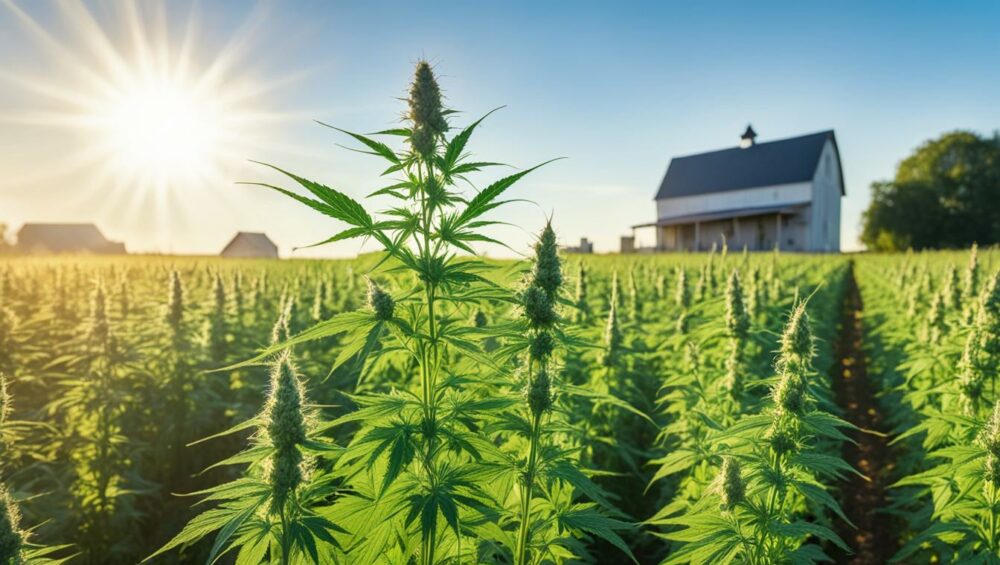Discover the captivating origins of CBD flower and embark on a journey to uncover its ancient secrets and modern advancements. CBD, derived from the cannabis plant, has gained significant attention for its potential therapeutic benefits. But where does CBD come from, and how is CBD flower sourced? Let’s delve into the fascinating world of CBD origins and explore the enchanting story behind this natural wonder.
Step into the realm of cannabis plants, where CBD flourishes amidst nature’s abundant offerings. CBD flower primarily originates from hemp, a variety of the cannabis plant that contains minimal levels of THC, the psychoactive compound found in marijuana. This distinction allows CBD to be enjoyed without inducing mind-altering effects, making it an appealing choice for those seeking holistic wellness.
Hemp is celebrated as the preeminent source of CBD due to its rich concentration of this valuable compound. The extraction process involves various methods, such as CO2 extraction or solvent extraction, to isolate and extract pure CBD from the hemp plant. These meticulous procedures ensure the highest quality and potency of CBD flower, unlocking its therapeutic potential.
As we unravel the mysteries of CBD flower, prepare to be captivated by its intriguing origins and explore the limitless possibilities it offers for well-being. Join us on this extraordinary journey to embrace the natural wonders of CBD and embark on a path towards a healthier and more harmonious life.
Origins and Sources of CBD: Nature’s Beneficial Gift
CBD, or cannabidiol, is a remarkable compound that comes from hemp, a variety of the cannabis sativa plant. Hemp is specifically cultivated for its CBD-rich flowers, which contain the highest concentration of CBD. What sets hemp apart from other cannabis varieties is its low THC content, which ensures that CBD products derived from hemp do not have psychoactive effects.
While hemp is the primary source of CBD, it’s important to note that CBD can also be sourced from marijuana, a cannabis variety with higher THC concentrations. However, CBD derived from marijuana may be subject to legal restrictions in some regions.
“Hemp, with its rich CBD content and minimal THC levels, holds immense potential to harness nature’s therapeutic benefits.” – Dr. Jane Greenfield
The Potency of CBD in Different Parts of the Hemp Plant
While CBD-rich flowers are the primary source of CBD, other parts of the hemp plant, such as leaves and stems, also contain CBD. However, the concentration of CBD in these parts is comparatively lower than in the flowers. This is why hemp flowers are the preferred choice for CBD extraction.
- Hemp flowers: Highest concentration of CBD
- Hemp leaves: Contain CBD, but at lower concentrations than flowers
- Hemp stems: Also contain CBD, but at lower concentrations than leaves
Cultivating Hemp for CBD: A Natural Treasure Hunt
Cultivating hemp with high CBD content requires expertise and careful cultivation practices. Factors such as soil quality, nutrient availability, and genetics play crucial roles in determining the CBD concentration within the hemp plant. It’s through these efforts that nature’s hidden treasures, in the form of CBD, can be uncovered and harnessed for various wellness and therapeutic purposes.
CBD Extraction from the Cannabis Plant
To unlock the therapeutic potential of CBD, it must first be extracted from the cannabis plant. This crucial process involves various methods that ensure the purity and potency of the final CBD product. Two commonly employed extraction methods are CO2 extraction and solvent extraction.
CO2 extraction:
Considered the gold standard of CBD extraction, CO2 extraction utilizes controlled conditions to achieve precise results. This method involves using carbon dioxide (CO2) in its supercritical state to extract CBD from the cannabis plant. Supercritical CO2 behaves as both a liquid and a gas, allowing it to penetrate the plant material and dissolve cannabinoids, terpenes, and other beneficial compounds. The resulting extract is rich in CBD while effectively filtering out unwanted components like chlorophyll and plant waxes.
Solvent extraction:
Solvent extraction involves the use of solvents like ethanol or butane to dissolve CBD and other desired compounds from the cannabis plant. This method is particularly effective at extracting a wide range of cannabinoids and terpenes. The plant material is soaked in the chosen solvent, allowing it to dissolve the CBD and other target compounds. The mixture is then further processed to remove the solvent, leaving behind a concentrated CBD extract.
The choice of extraction method significantly impacts the quality, potency, and safety of CBD products. CO2 extraction is widely regarded as the most precise and efficient method, as it allows for the selective extraction of CBD while preserving its integrity. On the other hand, solvent extraction can be cost-effective and suitable for large-scale production.

Table: Comparison of CBD extraction methods
| Extraction Method | Advantages | Disadvantages |
|---|---|---|
| CO2 extraction | – Precise and selective extraction – High-quality CBD extracts – Safe and eco-friendly |
– Expensive equipment – Complex setup and operation |
| Solvent extraction | – Cost-effective – Suitable for large-scale production – Can extract a wide range of compounds |
– Risk of residual solvent in the final product – Potential loss of terpenes |
CBD and THC: Distinct Sources of Therapeutic Potential
CBD and THC are two prominent compounds found in the cannabis plant. While they share some similarities, they also have distinct characteristics that contribute to their therapeutic potential.
CBD (cannabidiol) is a non-intoxicating compound that offers potential therapeutic benefits. It has gained significant attention for its ability to promote relaxation, reduce anxiety, and alleviate pain. Unlike THC, CBD does not produce psychoactive effects, making it a desirable option for those seeking the therapeutic benefits of cannabis without feeling “high”.
THC (tetrahydrocannabinol), on the other hand, is the psychoactive compound responsible for the intoxicating effects of marijuana. It is known for its strong psychoactive properties and is commonly associated with the recreational use of cannabis. However, THC can also have therapeutic benefits, such as pain relief and appetite stimulation, which make it a valuable component of certain medical treatments.
The extraction processes for CBD and THC can differ due to their varying concentrations in different cannabis plants. In CBD extraction, the focus is on obtaining CBD-rich extracts from hemp plants with low THC content. This ensures that the resulting CBD products contain minimal amounts of THC, meeting legal requirements and minimizing the risk of psychoactive effects.
It is important to note that the legality, safety, and appropriate usage of CBD and THC products may vary based on regional regulations. Before using any cannabis-related products, it is crucial to understand the legal framework and consult with a healthcare professional.
To better understand the unique properties of CBD and THC, the following table highlights their key characteristics:
| Compound | Therapeutic Benefits | Psychoactive Effects |
|---|---|---|
| CBD | Potential relaxation, anxiety reduction, and pain alleviation | Non-intoxicating |
| THC | Pain relief, appetite stimulation | Psychoactive |
CBD Concentration: Unveiling the Hemp Plant’s Hidden Treasures
The hemp plant harbors a treasure trove of CBD, with concentration levels varying across its various parts. These hidden gems hold the key to unlocking the plant’s therapeutic potential. Let’s delve deeper into the distribution of CBD within the hemp plant and discover where its true riches lie.
The flower buds of the hemp plant stand out as the crown jewels, boasting the highest concentration of CBD. These delicate buds, brimming with cannabinoids, terpenes, and other beneficial compounds, are the prized source for CBD extraction. Harnessing the potential of these CBD-rich flower buds enables the creation of high-quality CBD products that offer maximum therapeutic benefits.
While the flower buds shine the brightest, the leaves and stems of the hemp plant should not be overlooked. They also contain CBD, albeit in lower concentrations compared to the flower buds. The leaves, with their verdant green hues, and the sturdy stems possess their own contribution to the overall CBD content. In the hands of skilled cultivators and extractors, these parts can be efficiently utilized to obtain additional CBD from the hemp plant.
Unlocking the hidden treasures of CBD concentration requires a deep understanding of the factors that influence its distribution within the hemp plant. Cultivation practices play a vital role in determining CBD concentration, from the nutrient-rich soil that nurtures the plants to the careful manipulation of genetics to enhance CBD production. These factors, along with considerations like climate and stress response, contribute to the overall CBD content within the plant.
Promising Cultivation Practices for Enhanced CBD Concentration:
- Optimized Soil Nutrition: Ensuring the hemp plants receive adequate nutrients, such as nitrogen, phosphorus, and potassium, fosters healthy growth and increased CBD production.
- Strategic Harvesting: Timing the harvest to coincide with the ideal CBD concentration peak ensures optimal yield and potency.
- Genetic Selection: Identifying and cultivating hemp strains with naturally high CBD content or selectively breeding plants for increased CBD production boosts overall CBD concentration.
By grasping the intricacies of CBD distribution within the hemp plant, cultivators and extractors can optimize CBD extraction processes and create products with higher potency and efficacy. The pursuit of CBD concentration within the hemp plant unveils a wealth of possibilities for advancing the field of CBD research and product development.
The History of CBD: From Ancient Origins to Modern Revival
Explore the fascinating journey of CBD through time, from its ancient roots to its resurgence in modern times. The history of CBD stretches back thousands of years, with hemp cultivation playing a significant role in various civilizations.
Ancient cultures recognized the incredible potential of hemp and harnessed its versatile properties. From the creation of fabric and paper to the production of ropes and other materials, hemp was revered for its strength and durability. It was truly a golden resource, intertwined with everyday life.
In the 1800s, the medicinal benefits of hemp extracts began to emerge. Hemp became recognized as a valuable medicine in different regions, offering relief for various ailments. However, the road to widespread acceptance was not without challenges.
In the United States, hemp faced a tumultuous period in the 1930s when it was promoted as a billion-dollar crop. However, regulatory hurdles and a moratorium on cultivation temporarily halted its progress. But the tides turned with the passage of the 2018 Farm Bill, which breathed new life into hemp cultivation and propelled the CBD industry to new heights.
Today, despite obstacles in cultivation and processing, the history of CBD continues to evolve. The increasing popularity and acceptance of hemp-derived products signify a growing movement towards holistic wellness and natural alternatives. As we embrace this ancient plant’s potential, we pave the way for a future where CBD can be enjoyed by all.
FAQ
Where does CBD flower come from?
CBD flower is primarily sourced from hemp, a variety of the cannabis plant that contains low levels of THC and does not induce psychoactive effects.
What is the difference between hemp and marijuana as sources of CBD?
Hemp is distinguished by its low THC content, making it ideal for producing CBD without psychoactive effects. CBD can also be sourced from marijuana, which contains higher THC concentrations. However, CBD derived from marijuana may be subject to legal restrictions.
How is CBD extracted from the cannabis plant?
CBD is extracted from the cannabis plant using methods like CO2 extraction or solvent extraction. CO2 extraction is considered the gold standard of precision, while solvent extraction involves using solvents like ethanol or butane to dissolve CBD and other desired compounds.
What are the potential therapeutic benefits of CBD?
CBD offers potential therapeutic benefits such as relaxation, anxiety reduction, and pain alleviation. It is non-intoxicating and does not produce the intoxicating effects of marijuana.
Where is the highest concentration of CBD found in the hemp plant?
The flower buds of the hemp plant contain the highest concentration of CBD, making them ideal for CBD extraction. Leaves and stems also contain CBD, albeit in lower concentrations compared to flower buds.
What is the history of CBD?
The history of CBD dates back thousands of years, with evidence of hemp cultivation for medicinal and daily practical purposes. Hemp has been used for creating fabric, paper, rope, and other materials due to its strong and fibrous nature. Its medicinal potential was discovered in the 1800s, and hemp extracts became recognized medicine in various regions.







